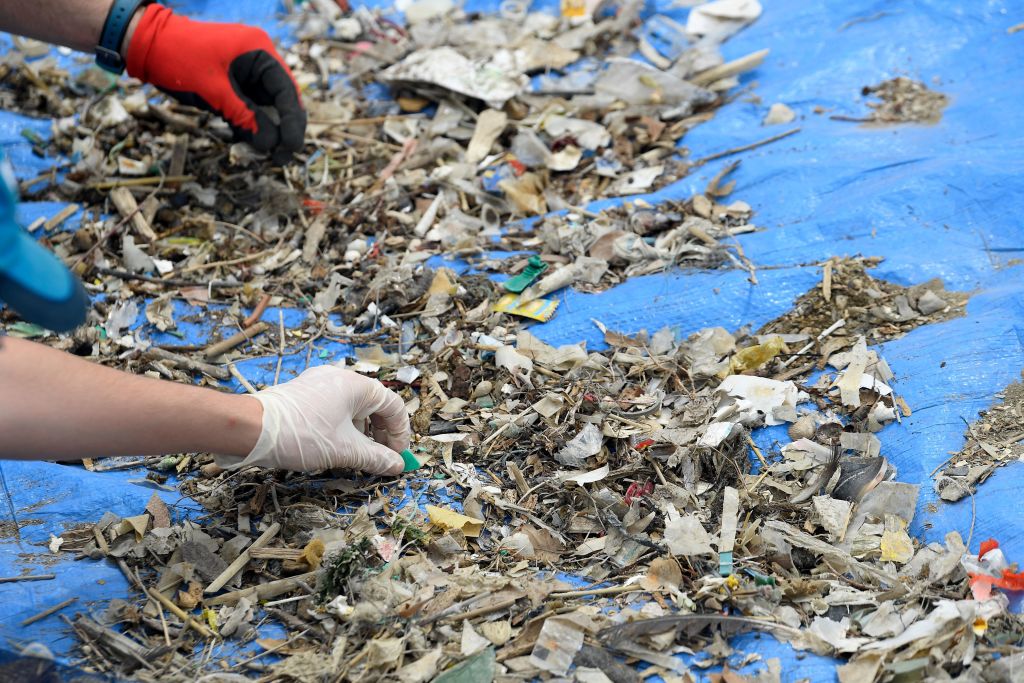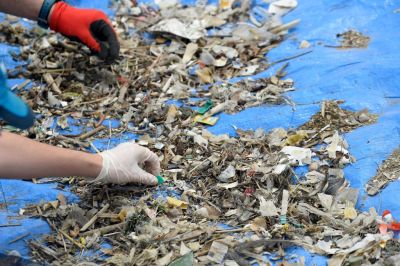If you consume the news, you’re probably aware that you also consume plastic—and an uncomfortably significant amount of it. One 2021 study that was amplified in a World Wildlife Fund for Nature report claimed that each of us may consume as much as one credit card’s worth of plastic a week. (It has since been discredited.)
Whatever the amount, you wouldn’t know you’re eating (and inhaling) plastic because it’s very, very small. These microplastics are tiny to microscopic bits and shards sloughed off vehicle tires as they roll down the highway, shed from slowly degrading plastic refuse, and shorn from synthetic fibers in clothes and bedding, among many other sources.
Although your body expels them the same way it expels other solids, microplastics can linger. According to Harvard Medicine, microplastics have been found “in the blood, saliva, liver, kidneys, and placenta … in human breast milk …” and in babies’ first stool.
That’s almost certainly a problem, but we’re only beginning to discover how big a problem it is. Even to researchers who’ve been studying them, microplastics are as inscrutable as they are invisible.
The tao of plastics.
Like many great human inventions that have come back to kick us in the tush, plastics offer great advantages. A 2009 paean to plastics in the U.K.-based journal Philosophical Transactions of the Royal Society B cites their contribution to health and safety, energy savings, and materials conservation. They help keep drinking water clean, provide sterile medical applications, help keep food safe, make buildings cheaper and more durable, and save energy through lighter vehicles.
In fact, plastics have been used so much since their modern invention in the 19th century that there’s about 6 billion metric tons of it around the globe according to Philip Demokritou, director of the Environmental Health Nanoscience Laboratory at Harvard University. This inventory is “constantly degrading,” he told Chemical & Engineering News in 2022, and 400 million metric tons are currently added each year (or more).
Plastics lose molecules from the moment they’re produced—even during their production. And plastics degrade over time, albeit slowly.
The resulting microplastics have been found all over the globe, “from the south to Antarctica, north to the Arctic, up to the peak of Mount Everest, and down to the Mariana Trench,” according to a 2023 review in the American Chemical Society’s Environment & Health. And since the first microplastics were detected in the Atlantic in the 1960s and 1970s, they’ve been found in lakes, rivers, and oceans; in the soil; in plants; and in wild and domesticated animals.
Microplastics generally are small bits of plastic in the environment. Definitions vary, but true microplastics are the larger bits, anywhere from 5 millimeters in diameter to 1 micrometer (0.001 millimeter). The smaller bits, nanoplastics, are less than 1 micrometer in diameter and can invade animal cells, including cell nuclei.
MNPs—which can refer to the entire range of micro- and nanoplastics—vary in shape, size, electrical charge, chemical makeup and additives, and propensity to carry other potentially toxic chemicals. All are factors that can cause specific damage to human bodies and produce different immune responses.
Plastic threats.
As late as 2022, in an extensive report on MNPs, the World Health Organization (WHO) could only say that the evidence against MNPs as a threat to human health was low “because of substantial limitations of the available information.”
The available data, it turned out, wasn’t very good. Most studies focused on larger MNPs that are less likely to be ingested or inhaled by humans, or on particles that aren’t found in the environment. Early studies focusing on the plastic beads found in cosmetics and lotions looked at spherical microplastics, for example, rather than the more common and potentially much more harmful jagged and non-uniform plastic particles.
Reporting has been inconsistent, the same report noted, and most of the research was simply unreliable.
Since that report, indications of a health threat posed by MNPs have been accruing.
The 2023 review in Environment & Health found evidence for “oxidative stress [a biologically destructive chemical imbalance], DNA damage, organ dysfunction, metabolic disorder, immune response, neurotoxicity, [and] reproductive and developmental toxicity.”
Especially worrisome, the same review found that pregnant women, fetuses, and newborns may be especially at risk, with much higher potential exposure in infants compared to adults.
But, as with the earlier WHO report, the review by its own admission could only be suggestive. It ended with a laundry list of recommended improvements to the science: better, more uniform analytical methods; improved understanding of how MNPs are absorbed and metabolized; and more studies on humans versus models, to name a few.
Even a widely reported paper as recent as this month was alarming but inconclusive. The New England Journal of Medicine cited microplastics as “a potential risk factor for cardiovascular disease in preclinical studies.” And yet, as the paper states up front, “direct evidence that this risk extends to humans is lacking.”
What can be done?
Researchers are making some progress, though. According to the same article in Chemical & Engineering News, a center established at Harvard University by Demokritou for nanosafety research has begun a program to study MNPs. It’s setting up a library of MNPs that will help it and other researchers “’discover the fundamental rules of bioactivity—how the structure or properties of materials affect health outcomes.’”
It will also seek to address that vast complexity of cause and effect posed by the wide variety of MNPs and speed up the research by focusing on experimental approaches that can most likely point to the most salient health risks to humans.
Focused and smarter regulation may also help. One expert interviewed in Chemical & Engineering News suggested that regulating a “large target source” like polyethylene terephthalate (PET), which is used in plastic drink bottles, could be effective in getting plastics manufacturers to work on safer alternatives.
Another expert in the same article points to improving the blunt instrument of the U.S. Food and Drug Administration, which regulates how much plastic can “’migrate’ from food packaging” based on total mass. This ignores the possibility that smaller MNPs, which may have a higher health risk, could add up to a combined mass that doesn’t reach the FDA’s limits. So regulations that are more sensitive to the realities and complexities of MNPs may be warranted.
Meanwhile, there are things we can do to limit our intake of MNPs: A start may be microwaving your morning oatmeal in something other than a Tupperware container.






Please note that we at The Dispatch hold ourselves, our work, and our commenters to a higher standard than other places on the internet. We welcome comments that foster genuine debate or discussion—including comments critical of us or our work—but responses that include ad hominem attacks on fellow Dispatch members or are intended to stoke fear and anger may be moderated.
With your membership, you only have the ability to comment on The Morning Dispatch articles. Consider upgrading to join the conversation everywhere.